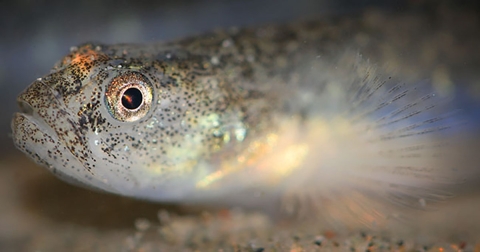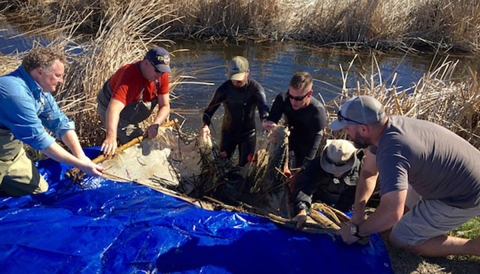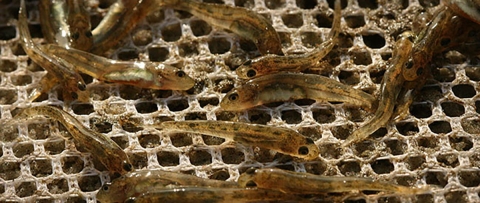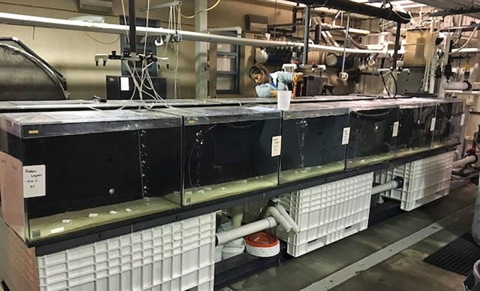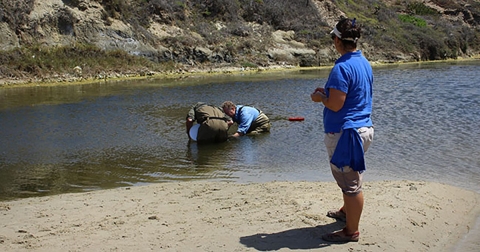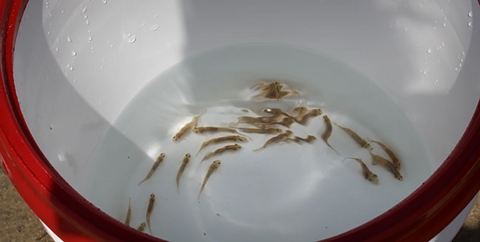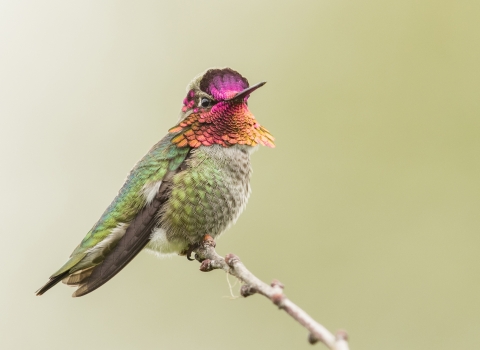While the promise of rain from this year’s El Nino was welcome news for drought-stricken California, the potential for the atmospheric anomaly’s gully-washing storms was bad news for tidewater gobies, a rare fish that inhabits coastal lagoons on Marine Corps Base Camp Pendleton in Southern California.
Tidewater gobies measure a little more than 2 inches long and are somewhat translucent. Although they are a small, short-lived fish, gobies have shown a surprising ability to withstand large variations in salinity and temperature, characteristic of its lagoon habitats. Tidewater gobies are bottom-dwelling fish, occurring in shallow coastal lagoons. They prefer sandy substrate for breeding and feed primarily on small invertebrates.
"The Tidewater Goby generally inhabit coastal brackish water estuaries and lagoons that experience some degree of seasonal closure, temporarily isolating them from the sea," explained Brenton Spies, a research biologist and PhD candidate at the Univiersity of California at Los Angeles (UCLA), who studies the rare fish.
"In the past, tidewater gobies could be found swimming in lagoons and estuaries along the entire length of the California coast," he said. "Development, loss of habitat and introduction of non-native predators have diminished the species’ range and left large gaps between populations."
Fortunately, Camp Pendleton covers more than 17 miles of coastline and supports eight lagoons and estuaries, three of which are currently occupied by the tidewater goby. The occurrences of gobies on Camp Pendleton are currently thought to be the only known locations of the species remaining south of Los Angeles County.
Camp Pendleton covers more than 125,000 acres in northern San Diego County, and is one of several military installations in California with a significant role in the conservation of rare fish, wildlife and plants. The diverse habitats found on the Base support 18 threatened and endangered species like the tidewater goby.
When El Nino storms threatened to inundate habitat for tidewater gobies, Camp Pendleton stepped up to help safeguard populations of this endangered native fish.
Dr. David Jacobs, a researcher at University of California, Los Angeles (UCLA), has been looking into the genetics of this small fish and his research on tidewater goby genetics has established a distinction of the tidewater goby in the southern portion of its range. Dr. Jacobs contacted the U.S. Fish and Wildlife Service to express his concern that the magnitude of predicted storm events triggered by El Nino could flush the tidewater gobies out to open ocean, potentially resulting in further loss of these unique southern California populations.
Although scientists recognize that regular breaching of lagoon systems and flushing of individuals into the open ocean is part of their life history strategy, suitable habitat for the species in the southern portion of its range is currently limited. Out of an abundance of caution, the Service coordinated with Camp Pendleton to arrange for an emergency salvage effort to ensure the safety of a portion of the remaining goby populations.
“The Marine Corps is an important partner in conserving species and habitats. Their willingness to assist in this goby conservation effort on Camp Pendleton ensured the fish in this portion of its range would be protected in the event of a catastrophic El Nino event,” said Mendel Stewart, field supervisor of the Service’s Carlsbad Fish and Wildlife Office.
The Birch Aquarium at Scripps and the Santa Monica Pier Aquarium were already poised to provide temporary refugia for the gobies.
Over the course of one very long day in February, Spies, along with biologists from Camp Pendleton, the Service, California Department of Fish and Wildlife, and the Santa Monica Pier Aquarium conducted the emergency collection.
Armed with dip nets and aerated buckets, they waded into San Onofre Creek, Hidden Lagoon, and Cockleburr Canyon Creek to carefully capture gobies. A total of 376 gobies were successfully removed and transported to temporary refugia at the Birch and Santa Monica Pier Aquariums.
"These two aquariums reacted quickly and graciously agreed to provide temporary housing and care for the gobies until the risk of El Niño storms has diminished," said Spies.
On April 29, after the threat of El Nino storms passed, researchers transported the gobies from the Birch Aquarium and Santa Monica Pier Aquarium to Camp Pendleton where they were returned to their native lagoons.
To ensure the fish would survive the transfer back to the lagoons, temperature and salinity readings were taken at each of the three lagoons. By slowly adding lagoon water to the buckets, the gobies were given time to acclimate prior to release.
Although the return of the gobies back to their native habitat was a low key event, the process of collecting, housing, transporting, and releasing them required considerable planning and the cooperative efforts of numerous individuals.
“Overall, the protective action was important to do,” said Jacobs. “Given the high risk to this southern species, such actions are essential unless and until, more populations can be established.”
"While this emergency rescue was critical to save the species, it is only a short-term solution, " added Spies. "The California coast represents valuable real estate and estuarine habitat must continue to be protected in order to conserve the goby along with the plants and animals that share its habitat."

